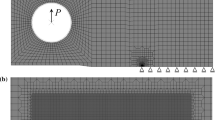Abstract
Fatigue crack closure and crack growth behaviour in Ti–2.5 wt % Cu alloy with two equiaxed and two lamellar microstructures have been investigated by constant-load amplitudetests. Plasticity-induced crack closure and roughness-induced crack closure have been characterized separately by experimental methods. A change in closure mechanism from plasticity-induced crack closure at high ΔK values (region of high stress intensity ranges)to roughness-induced crack closure at low ΔK values occurs in a solution-annealed equiaxed microstructure, while plasticity-induced crack closure is the operative closure mechanism in an over-aged equiaxed microstructure over the whole range of ΔK and roughness-induced crack closure occurs in two lamellar microstructures. The crack closing stress intensity factor for plasticity-induced crack closure increases continuously with increasing maximum stress intensity. The crack closing stress intensity factor for roughness-induced crack closure increases with increasing maximum stress intensity at low ΔK, and remains constant at high ΔK. Crack closure and crack path deflection have a significant influence on the crack growth rates. © 1998 Kluwer Academic Publishers
Similar content being viewed by others
References
W. Elber, Engng Fracture Mech. 2 (1970) 37.
Idem, in “Damage Tolerance in Aircraft Structures”, ASTM STP 486 (American Society for Testing and Materials, Philadelphia, PA, 1971) p. 230.
S. Suresh, in “Plastic Deformation and Fracture of Materials”, Materials Science and Technology, Vol. 6, edited by R. W. Cahn, P. Haasen and E. J. Kramer (VCH Verlagsgesellschaft mbH, Weinheim, 1993) p. 281. f
R. O. Ritchie and S. Suresh, Metall. Trans. A 13A (1982) 937.
S. Suresh and R. O. Ritchie, ibid. 13A (1982) 1627.
S. Suresh, G. F. Zamiski and R. O. Ritchie, ibid 13A (1982) 1627.
H. Kobayashi, H. Tsuji and K. D. Park, in “Fracture and Strength '90”, Key Engineering Materials, Vols 51 and 52, edited by K. Y. Lee and H. Takahashi (Trans Tech Publications, Zürich, 1990) p. 355.
P. K. Liaw, T. R. Leax, R. S. Williams and M. G. Peck, Metall. Trans. A 13A (1982) 1607.
S. Dhar, in “'90”, edited by H. Kitagawa and T. Tanaka (Materials and Component Engineering Publications Ltd, Birmingham, 1990) p. 1261.
P. J. Cotterill and J. F. Knott, Acta Metall. Mater. 40 (1992) 2753.
L. P. Zawada and T. Nicholas, in “Fracture Mechanics: Eighteenth Symposium”, ASTM STP 945, edited by D. T. Read and R. P. Reed (American Society for Testing and Materials, Philadelphia, PA, 1988) p. 192.
A. K. Vasudevan, K. Sadananda and N. Louat, Mater. Sci. Eng. A188 (1994) 1.
N. Louat, K. Sadananda, M. Duesbery and A. K. Vasudevan, Metall. Trans. A 24A (1993) 2225.
J. D. Dougherty, T. S. Srivatsan and J. Padovan, Engng Fracture Mech. 56 (1997) 167.
R. Rippin, C. Bichler, C. Sommitsch and O. Kolednik, in “Fatigue '96”, edited by G. Lütjering and H. Nowack (Elsevier Science, Oxford, 1996) p. 411.
R. C. Mcclung, B. H. Thacker and S. Roy, Int. J. Fracture 50 (1991) 27.
R. Pippan, O. Koledink and M. Lang, Fatigue Fracture Engng Mater. Struct. 17 (1994) 721.
K. Asami, in “Fractography”, Current Japanese Materials Research, Vol. 6, edited by R. Koterazawa, R. Ebara and S. Nishida (Elsevier Applied Science, Ltd, 1990) p. 1.
P. A. Blenkinsop and R. E. Goosey, in “The Science, Technology and Application of Titanium”, edited by R. I. Jaffe and N. E. Promisel (Pergamon Press, Oxford, 1970).
H. E. Exner, Pract. Metallogr. 30 (1993) 287.
N. A. Fleck, The use of compliance and electrical resistance techniques to characterise fatigue crack closure, Report No. CUED/C/MATS/TR89, (Department of Engineering, Cambridge University, Cambridge, 1982).
S.-H. Wang, PhD thesis, Technical University of Darmstadt, Germany, (1997).
S.-H. Wang and C. MÜller, Mater. Sci. Eng. A (1998) in press.
J. WasÉn, B. Karlsson and K. Hamberg, Acta Stereol. 6 (1987) 199.
S. Suresh, Metall. Trans. A 14A (1983) 2375.
Idem, ibid. 16A (1985) 249.
T. Ogawa, K. Tokaji and K. Ohya, Fatigue Fracture Engng. Mater. Struct. 16 (1993) 973.
S. V. Kamat and N. Eswara prasad, Scripta Metall. Mater. 26 (1992) 1713.
F.-S. Lin and E. A. Starke, Mater. Sci. Eng. 43 (1980) 65.
S.-H. Wang and C. MÜller, Fatigue Fracture Engng. Mater. Struct. 21 (1998) in press.
S.-H. Wang, C. MÜller and H. E. Exner, Metall. Mater. Trans. A 29A (1998) 1933.
R. C. Mcclung and H. Sehitoglu, Engng Fracture Mech. 33 (1989) 237.
M. F. Kanninen and C. Atkinson, Int. J. Fracture 16 (1980) 53.
T. Ogawa and H. Kobayashi, Fatigue Fracture Engng. Mater. Struct. 10 (1987) 273.
R. O. Ritchie, W. Yu, A. F. Blom and D. K. Holm, ibid. 10 (1987) 343.
Author information
Authors and Affiliations
Rights and permissions
About this article
Cite this article
Wang, SH., MÜLler, C. Fatigue crack closure and crack growth behaviour in a titanium alloy with different microstructures. Journal of Materials Science 33, 4509–4516 (1998). https://doi.org/10.1023/A:1004491932456
Issue Date:
DOI: https://doi.org/10.1023/A:1004491932456




